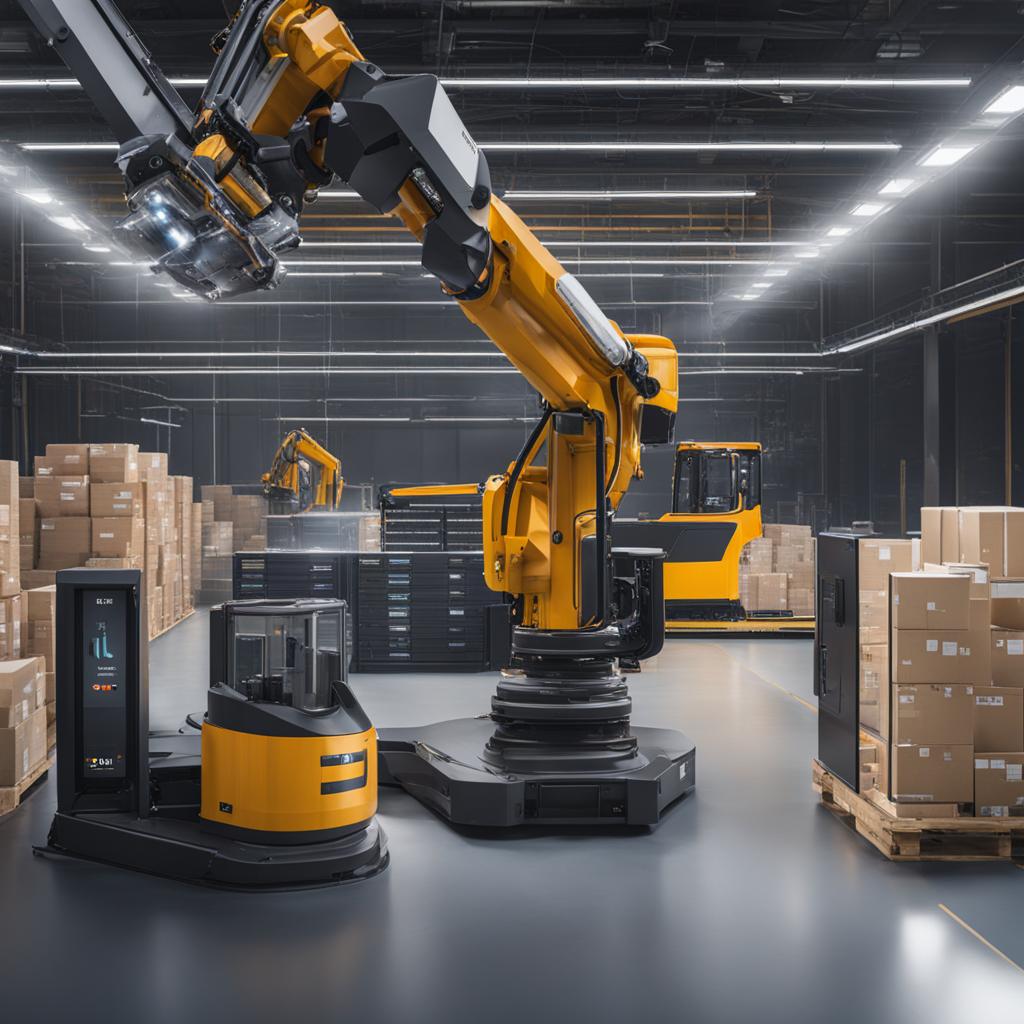The Efficient supply chain management is an indispensable component for any modern company that wants to survive in an increasingly networked economy. Digitalization has opened up new opportunities for Supply chain optimization which significantly increases the performance and competitiveness of companies. Using software platforms like FourKites Digital supply chain managementto achieve real-time visibility through the use of machine learning and artificial intelligence. This technology has Supply Chain Management revolutionized and makes it possible for companies to use Logistics apps to react quickly and make informed decisions.
Important findings
- With advanced Supply chain management apps companies can optimize their processes in Monitor and optimize in real time.
- Digitization and transparency in the Supply Chain Management are essential for modern logistics processes.
- Intelligent software platforms facilitate risk management and improve the adaptability of supply chains.
- The integration of Logistics apps contributes to increasing efficiency and reducing costs.
- The use of machine learning and Artificial intelligence in Supply chain management apps offers detailed Forecasts and facilitates the decision-making process.
The importance of transparency in modern supply chains
In this day and age, the Transparency in the supply chain a fundamental requirement in order to cope with the rapid changes in the global economy. Supply chain management apps have become an indispensable tool for the Supply chain optimization have become. They enable companies to maintain a clear overview of their entire supply chain at all times and thus respond effectively to challenges.
Definition of transparency in the supply chain
Real-time tracking and monitoring of assets are essential building blocks for a transparent supply chain. With the help of digital technologies relevant data points are recorded and processed in order to convert them into actionable insights and thus continuously improve the supply chain.
Influence of real-time data on supply chains
Real-time data is at the heart of advanced Supply chain optimization tools. They provide companies with immediate information about traffic, delays and other critical events, which leads to improved response times and more efficient logistics processes.
Customer requirements for traceable delivery routes
Today, customers not only expect high-quality products, but also a high degree of transparency about the path their goods take. This includes precise information about delivery times as well as insights into the ethical aspects of production and the use of resources.
Supply chain management apps and their role in digitalization
The landscape of the Supply Chain Management is changing rapidly due to the introduction of Supply chain management appswhich enable precise monitoring and analysis of all logistics processes. Within the digital supply chain management these applications form the interface between data streams and operational decisions. The effective use of these technological advances leads to an optimization that promises previously unattainable increases in efficiency.
With the help of Logistics softwareequipped with algorithms of the machine learninga variety of data sources from the entire supply network are integrated in real time. Combined with powerful analytics, this gives companies Direct access to important findingswhich enables adaptive and dynamic management of the supply chain.
- Acceleration of decision-making processes through access to real-time data.
- Strengthening the competitive position through increased reaction speed to market changes.
- Improving customer relations through a transparent and reliable information policy.
The Implementation an intelligent Supply chain management app is similar to opening the curtain to a previously hidden area of the company that is now fully visible and controllable. This not only applies to large corporations, but also offers small and medium-sized companies the opportunity to significantly improve their own efficiency.
A tabular overview of the core functions of modern management apps is as follows:
| Function | Benefit |
|---|---|
| Data integration | Centralization of a wide variety of data from the entire supply chain. |
| Real-Time Monitoring | Continuous monitoring and immediate feedback on the status of delivery points. |
| Prognostics & Analytics | Use of predictive analytics to forecast future events and trends. |
| Automated decision support | Recommendations for efficient options for action based on machine learning. |
The confluence of these properties in a central application embodies the current state and future potential of the Supply Chain Management. With the continuous further development of these technologies Supply chain management apps lay the foundation for a more progressive, networked business world.
Strategies for optimizing supply chains
In the age of digitalization Intelligent solutions and Process automation Key elements for increasing efficiency and realizing the Supply chain optimization. Companies that invest in innovative supply chain management apps position themselves at the forefront of technological progress and benefit from a sharpened competitive edge. These apps offer the opportunity to redesign processes and take the supply chain to the next level.
Process automation through intelligent solutions
The Implementation from Process automation in supply chain management apps helps to minimize human error and standardize processes. The use of AI and machine learning not only makes processes more efficient, but also more flexible so that they can react to unforeseen events.
- Automated inventory management
- Intelligent route planning and shipment tracking
- Automation of procurement processes
Improving the flow of information
An uninterrupted and precise flow of information is the foundation for the agile adaptability of a supply chain. Digital supply chain management apps ensure optimized communication between all links in the supply chain and thus improve the coordination of deliveries and inventories.
| Process | Advantages |
|---|---|
| Central dashboard | Overview of all relevant supply chain information |
| Cloud-based data | Secure and location-independent data availability |
| Collaborative working environment | Simplified collaboration and exchange of information |
Reduction of supply bottlenecks
Forward-looking risk management and continuous monitoring of the supply chain allow potential supply bottlenecks to be identified and counteracted in good time. The Supply chain optimization consists of precise analysis tools and notification systems that allow you to react quickly and effectively to faults.
- Early warning systems for impending bottlenecks
- Algorithms for demand forecasting and stock alerting
- Dynamic adaptation of delivery strategies in response to real-time data
Modern companies that make use of these advanced technologies and concepts ensure that their supply chains are not just resilientbut also Adaptable and transparent are facing the many challenges of global trade.
Technology trends in supply chain management
The dynamics of the global markets require constant adjustments and innovations in the area of Supply Chain Management. Current Technology trends such as the Internet of Things (IoT), Digital Twins, Process Mining and intelligent automation are at the forefront of development and are driving the Supply chain optimization ahead. These technical innovations are paving the way for an efficient, Digital supply chain managementthat enables companies to operate at a new level of agility and foresight.
IoT-connected sensors and devices collect data from every point in the supply chain, enabling real-time insight and decision-making. Digital Twinsvirtual images of physical processes and objects, allow managers to simulate processes and carry out optimizations before physical changes are made.
Process Mining analyzes operational process data to uncover inefficiencies and identify potential for improvement. Finally, intelligent automation combines software robots with artificial intelligence to perform repetitive and complex tasks reliably and efficiently.
- Effective real-time forecasts and reliable data analysis
- Increased transparency and control through digital twins
- Process mining for continuous process improvements
- Advantages of automation for time-intensive processes
The Implementation of these advanced technologies is leading to a profound transformation of supply chain structures and enabling companies to stay at the forefront of the digital age.

The challenge for companies now is to strategically integrate these technological opportunities and convert them into tangible benefits within their supply chains. This is the only way they can reap the rewards of comprehensively digitized and optimized supply chain management and strengthen their market position.
From reactive to proactive supply chain management
The switch from reactive to proactive supply chain managementThe development of new strategies is essential today in order to be successful in a marketplace characterized by fast-paced change and uncertainty.
Proactive supply chain management aims not only to manage potential disruptions and risks to the supply chain, but also to avoid them in the first place. To this end Risk analyses and preventive measures are used to give us a head start through the use of intelligent technology and data science.
Identification of risks before they arise
The early detection of risks is an indispensable component of modern risk management. Supply Chain Management. Tools and apps that enable proactive management are designed to identify potential sources of disruption at an early stage and provide appropriate warning systems. This enables companies to develop an improved risk prevention strategy and remain competitive.
Efficient action through preventive data analysis
At the center of proactive management is the Data analysis. Enormous amounts of data are collected and analyzed in real time to enable preventive action. These strategic data points can be crucial for all areas of supply chain management, from route planning to inventory management.
| Range | Goal | Benefit |
|---|---|---|
| Risk identification | Establish an early warning system | Gain time for countermeasures |
| Analytics | Data-based Forecasts | Basis for effective planning |
| Inventory management | Optimized use of goods | Cost reduction & service improvement |
| Decision making | Speed of reaction | Increase in operational performance |
The change from a reactive to a proactive approach opens up new opportunities. Supply Chain Managers new opportunities to increase efficiency and reduce risks, which ultimately leads to an improved position on the market.
Integrating AI and machine learning into supply chain management apps
The progressive integration of Artificial intelligence (KI) and Machine Learning in Supply chain management apps opens up impressive prospects for efficiency and precision. These technologies are revolutionizing the forecasting of goods flows and the associated decision-making processes within the Supply Chain Management. In particular, they allow insights into large volumes of data and their useful interpretation in order to strengthen companies in global competition.
Potential of artificial intelligence for forecasts
The Artificial intelligence plays a key role in the accuracy of Forecasts one. Its ability to learn from historical data and predict future trends is hugely important for supply chain management. By recognizing patterns in order histories, traffic patterns and seasonal fluctuations, AI enables informed estimates for demand forecasts and delivery times. It is this predictive power of AI systems that underpins an effective supply chain strategy and enables optimization of the flow of goods and warehousing.
Machine learning for improved decision-making processes
While Artificial intelligence forms the basis for efficiency in analysis and forecasting, it is Machine Learningwith regard to Decision-making processes makes the difference. Self-learning algorithms make it possible to derive immediate recommendations for action based on real-time data. This technology favors precise and quickly implementable decisions that improve operations and can also respond to individual customer needs. This not only optimizes processes, but also the Customer satisfaction increased.

- Improved forecasting models: AI systems create models that forecast deliveries, consumption and demand peaks with greater accuracy.
- Real-time responsiveness: Machine learning enables rapid adaptation to changing market conditions and disruptions in the supply chain.
- Personalized customer approach: Individual customer needs can be better understood and served by analyzing and predicting customer behavior through machine learning.
The Number 8 reflects the progress in the Supply chain management by symbolizing the integration of AI and machine learning. These technologies are at the heart of advanced supply chain management apps and are paving the way for a new era of automated, intelligent supply chain operations.
The future: networked and self-controlling supply chains
The vision of the modern Supply Chain Management manifests itself in intelligent, networked supply chains and self-controlling systems. Such advanced solutions are no longer just science fiction, but are becoming reality through the interaction of IoT, AI and digital twins. Companies around the world are working on the development and implementation of these systems, which promise seamless integration of all processes in the supply chain.
The Networked supply chain means that all components - from procurement to production and distribution - communicate with each other in real time. Sensors, intelligent labels and data analysis ensure a constant flow of information. These networked systems identify and react independently to changes and disruptions, creating unprecedented agility.
"By using self-controlling supply chains, we can react proactively to the changing demands of the markets" - a quote that underlines the need for agility and flexibility in today's economic environment.
Crucial to this transformation is the use of Artificial intelligencewhich forms the heart of self-controlling supply chains. It continuously learns, optimizes processes and independently makes decisions that go beyond conventional automated systems.
- Intelligent algorithms ensure efficient route and inventory planning.
- Automated processes lead to a significant reduction in errors and failures.
- The increased transparency and traceability promote the trust of customers and partners.
As the nucleus of a digital-transformative journey in the area of the Supply Chain Management these technologies not only offer potential savings, but also create sustainable value for companies and their customers. Large amounts of data generated along the supply chain can now be used effectively to improve processes and inform decisions.
The consequences are far-reaching: not only in logistics, but also in sectors such as manufacturing, retail and the pharmaceutical industry. Networked and self-controlling supply chains their potential and lead to real competitive advantages. They help to achieve the main objectives of the Supply Chain Management - efficiency, speed and customer focus - while remaining resilient in a rapidly changing world.
Practical examples of successfully implemented supply chain optimization
The digitalization of the supply chain is an ongoing revolution that enables innovative business models, process improvements and customer solutions. A central element in this transformation are Digital twinsdigital images of physical systems, which offer extensive advantages in planning and operation. On the basis of concrete Case Studies illustrate how companies can benefit from the use of digital technologies to the Supply chain optimization significantly increase their effectiveness.
Case study: Use of digital twins in supply chain management
The US company C&S Wholesale Grocers was faced with the challenge of refining its operational processes and optimizing the Customer satisfaction to increase. Through the implementation of Digital twins a precise simulation of the company's processes could be created. This facilitated more effective resource planning and wagon allocation, which led to a reduction in time-consuming customer communication by a considerable 65% within just four months. This impressively demonstrates the potential of digital twins in the Supply chain optimization.
3M and the effective handling of times of crisis
During the COVID-19 pandemic, the multi-technology group 3M was faced with the challenging task of rapidly increasing deliveries of N95 protective masks. Through the use of the Supply chain management app of FourKites, 3M was able to achieve increased transparency and control of its supply chain. This agility during the crisis was a decisive factor in ensuring the supply of vital medical products and is an example of how essential Crisis management and flexibility within the Supply Chain Management are.
Real-time supply chain management and the impact on the customer experience
The digital transformation of supply chains, the Real-time supply chain management which fundamentally redesigns the customer experience. Transparent processes and the provision of information in real time contribute significantly to increasing the Customer satisfaction with. This progress creates a new level of customer loyalty and has a positive effect on long-term loyalty to the company.
Increasing customer satisfaction through transparent processes
Transparent processes in the Supply Chain Management are no longer a luxury these days, but a basic customer expectation. Precise information about the status of orders and deliveries, which is made available through applications for the Real-time supply chain management The customer loyalty programs that are provided enable companies to strengthen the trust of their customers and maintain satisfaction at a consistently high level.
Relevance of timely information for end consumers
For end consumers in particular, access to up-to-date information on the whereabouts and status of their orders is playing an increasingly important role. Informed customers appreciate the ability to track the entire order and delivery process, which is a direct result of transparent processes is.
In a world where the term "11" is synonymous with comprehensive, holistic approaches and top performance, the digital solutions in supply chain management, the maximum realization of efficient, customer-oriented business processes. They offer companies the opportunity to position their brand as trustworthy and customer-friendly, which leads to a decisive competitive advantage and increases the customer's loyalty. Customer satisfaction sustainably.
Implementing a supply chain management app: a step-by-step guide
The digitalization of supply chain management through the Implementation one Supply chain management app is a strategic step that requires careful planning and a methodical approach. Below you will find a Guidewhich outlines the key steps for the successful introduction and use of such an app in the company.
- Analysis of the existing system: Before a new app is introduced, the existing system must be analyzed in detail. This includes an evaluation of the current processes, an analysis of weak points and an understanding of user requirements.
- Target definition: Clear goals are essential for the success of the implementation. Define what you want to achieve with the new app - be it improving transparency, speeding up processes or reducing costs.
- Selection of the provider and tools: Not every software is suitable for every company. Choose a provider and a tool that meets your specific needs and can be seamlessly integrated into your IT landscape.
- Training and change management: For the app to be fully effective, employees need to be trained accordingly and prepared for the changes. Well thought-out change management ensures a smooth transition.
- Continuous feedback: Implementation is a process that needs to be monitored and optimized even after the launch. Regular feedback from users helps to improve the app and adapt it to the needs of the company.
The introduction of a Supply chain management app is more than just a technical process; it is an investment in future agility and success. With this Guide as a guide, you are well on the way to successfully mastering the implementation process and taking your supply chain processes to the next level.
Conclusion
The constantly changing landscape of global trade calls for a efficient supply chain managementthat not only dares to make the leap into the digital modern age, but also masters it. Supply chain management apps play a crucial role in this by providing transparency and Process automation seamlessly into the processes and help to capture and optimize the overall picture of the supply chain.
The digital transformation of the supply chain is no longer a distant dream of the future - it is already in full swing. Companies that know how to face up to this development and exploit the potential of automation and analysis tools are setting the course for a sustainable future. The future of supply chain managementwhich promotes resilient and at the same time dynamic structures.
The outlook is clear: Digital supply chain management goes hand in hand with increased competitiveness and customer focus. In a market environment dictated by speed and flexibility, modern supply chain management solutions offer the technology required to respond quickly and effectively to changes. For forward-looking companies, this means a significant advantage: not only can they better meet the current needs of their customers, but they are also optimally prepared for future challenges.
FAQ
What is efficient supply chain management?
Efficient supply chain management comprises the planning, control and optimization of all logistics processes for the delivery of goods. It integrates modern technologies in order to shorten delivery times, reduce costs and optimize Customer satisfaction to increase.
How does digital supply chain management improve the supply chain?
Digital supply chain management uses technologies such as AI and machine learning to automate processes, provide real-time visibility and make decisions based on real-time data. This increases transparency and efficiency across the entire supply network.
What role do supply chain optimization tools play?
Supply chain optimization tools help to analyze logistics processes, identify bottlenecks and uncover potential for improvement. They are central to the data-driven management of supply chains in order to make them more resilient and flexible.
How does transparency in the supply chain contribute to customer loyalty?
Customers want visibility into the status of their orders and the ethical aspects of the supply chain. Supply chain transparency can strengthen trust and lead to higher customer satisfaction and loyalty.
How do supply chain management apps support companies with digitalization?
Supply chain management apps offer advanced monitoring and analytics capabilities that break down data silos and enable integrated supply chain control. This promotes the digital transformation from traditional to networked, data-driven processes.
What does process automation in supply chain management apps mean?
Process automation in supply chain management apps refers to the use of software and technology to automate repetitive tasks, minimizing human error and increasing efficiency.
How does reducing supply bottlenecks help companies?
By reducing supply bottlenecks, companies can ensure delivery reliability, increase customer satisfaction and reduce costs. Supply chain management apps help to identify risks at an early stage and adapt processes.
Which technology trends will shape future supply chain management?
Trends such as IoT, digital twins, process mining and automated systems enable more accurate forecasting and fully automated supply chain processes, heralding a new era of supply chain management.
How do you recognize a proactive approach to supply chain management?
A proactive approach is characterized by early risk identification and forward-looking planning. This enables companies to react flexibly to changes and prepare the supply chain against potential disruptions.
What potential does artificial intelligence offer for forecasting in supply chains?
Artificial intelligence can improve predictions of demand and delivery times by analyzing large amounts of data and identifying patterns, enabling precise supply and demand planning.
How are networked and self-controlling supply chains changing the industry?
Networked and Self-controlling supply chains are revolutionizing the industry with autonomous processes that achieve better efficiency, lower costs and increased speed in supply chains.
What does the case study on digital twins in SCM from C&S show?
The Case Study about C&S illustrates how digital twins enable precise modeling of the operational structure, which improves problem detection and resolution and increases customer service efficiency.
How does real-time supply chain management affect the customer experience?
Real-time management of the supply chain ensures up-to-date information for the customer and increases the reliability of deliveries, resulting in increased customer satisfaction.
What steps are necessary to implement a supply chain management app?
For the implementation of a Supply chain management app includes analyzing existing processes, defining specific requirements, selecting suitable technologies and tools and training employees to use the app effectively.


Recent Comments